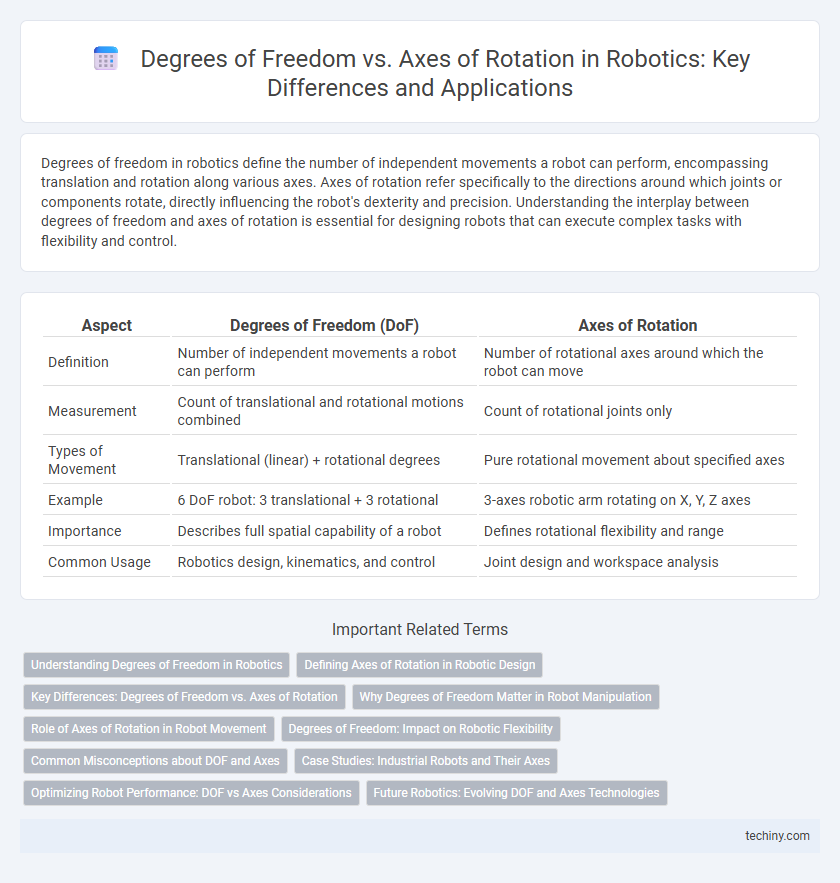Degrees of freedom in robotics define the number of independent movements a robot can perform, encompassing translation and rotation along various axes. Axes of rotation refer specifically to the directions around which joints or components rotate, directly influencing the robot's dexterity and precision. Understanding the interplay between degrees of freedom and axes of rotation is essential for designing robots that can execute complex tasks with flexibility and control.
Table of Comparison
| Aspect | Degrees of Freedom (DoF) | Axes of Rotation |
|---|---|---|
| Definition | Number of independent movements a robot can perform | Number of rotational axes around which the robot can move |
| Measurement | Count of translational and rotational motions combined | Count of rotational joints only |
| Types of Movement | Translational (linear) + rotational degrees | Pure rotational movement about specified axes |
| Example | 6 DoF robot: 3 translational + 3 rotational | 3-axes robotic arm rotating on X, Y, Z axes |
| Importance | Describes full spatial capability of a robot | Defines rotational flexibility and range |
| Common Usage | Robotics design, kinematics, and control | Joint design and workspace analysis |
Understanding Degrees of Freedom in Robotics
Degrees of freedom (DOF) in robotics refer to the number of independent motions a robot can perform, typically involving translations and rotations in three-dimensional space. Each degree of freedom corresponds to an independent axis of motion, such as pitch, yaw, or roll, enabling complex manipulator movements and precise positioning. Understanding the relationship between DOF and axes of rotation is essential for designing robots capable of versatile tasks, including assembly, welding, and surgical procedures.
Defining Axes of Rotation in Robotic Design
Axes of rotation in robotic design refer to the fixed lines around which a robot's joints rotate, defining the robot's movement capabilities and spatial orientation. Each axis represents one degree of freedom, allowing precise control of angular motion essential for tasks requiring dexterity and accuracy. Understanding and optimizing these axes enable engineers to design robots with appropriate flexibility, ensuring efficient operation in varied industrial applications.
Key Differences: Degrees of Freedom vs. Axes of Rotation
Degrees of freedom (DOF) in robotics refer to the number of independent movements a robot arm or joint can perform, typically including translation and rotation, whereas axes of rotation denote the specific lines around which the robot's parts rotate. The key difference lies in that DOF encompasses both linear and rotational movements contributing to a robot's flexibility, while axes of rotation exclusively count rotational movements about fixed lines. Understanding these differences is critical for designing robotic systems with precise maneuverability and control in applications such as industrial automation and surgical robotics.
Why Degrees of Freedom Matter in Robot Manipulation
Degrees of freedom (DOF) in robotics define the number of independent movements a robot manipulator can perform, directly impacting its dexterity and precision. Each axis of rotation corresponds to one DOF, enabling complex tasks such as grasping, positioning, and orienting objects in three-dimensional space. Higher DOF allows robots to execute intricate maneuvers necessary for advanced applications like assembly, surgery, and autonomous exploration.
Role of Axes of Rotation in Robot Movement
Axes of rotation define the specific directions in which a robotic joint can pivot, critically shaping the robot's range of motion and maneuverability. Each axis corresponds to a rotational degree of freedom, enabling precise movements such as pitching, yawing, or rolling. Understanding and optimizing these axes enhances robotic performance in tasks requiring dexterity, precision, and complex path execution.
Degrees of Freedom: Impact on Robotic Flexibility
Degrees of freedom (DOF) in robotics define the number of independent movements a robot can perform, directly influencing its operational flexibility and precision. Each degree of freedom corresponds to a specific axis of rotation or linear translation, enabling complex maneuvers and adaptability in dynamic environments. Higher DOF enhances a robot's ability to execute intricate tasks by allowing multi-directional motion beyond simple joint rotations.
Common Misconceptions about DOF and Axes
Degrees of freedom (DOF) refer to the number of independent movements a robotic system can perform, while axes of rotation indicate specific directions around which parts of the robot rotate. A common misconception is equating the number of DOF directly with the number of axes, overlooking that DOF can include translational movements, not just rotational ones. Understanding the distinction aids in precise robot design, control, and application in complex environments.
Case Studies: Industrial Robots and Their Axes
Industrial robots typically feature multiple degrees of freedom (DOF) to enhance precision and flexibility during operation, with common configurations ranging from 4 to 7 DOF. Each degree of freedom corresponds to a specific axis of rotation or linear movement, crucial for tasks such as welding, assembly, and material handling. Case studies reveal that 6-axis robots dominate industrial applications due to their ability to replicate complex human arm movements, optimizing reach and orientation in confined workspaces.
Optimizing Robot Performance: DOF vs Axes Considerations
Optimizing robot performance requires a clear understanding of degrees of freedom (DOF) versus axes of rotation, where DOF represents the total number of independent movements a robot can perform, and axes refer to the specific rotational directions available at each joint. Increasing DOF enhances flexibility and precision in complex tasks like assembly and manipulation, while carefully selecting axes of rotation ensures efficient motion paths and reduces mechanical strain. Balancing these factors is crucial for designing robots that achieve optimal dexterity, speed, and energy efficiency in industrial automation and service applications.
Future Robotics: Evolving DOF and Axes Technologies
Future robotics will feature advanced degrees of freedom (DOF) and axes of rotation, enabling unprecedented robot dexterity and precision. Emerging technologies integrate multi-axis actuators and smart materials, revolutionizing motion control and adaptability. These innovations promise to elevate robotic applications in complex environments such as surgical systems, autonomous navigation, and agile manufacturing.
Degrees of freedom vs axes of rotation Infographic

 techiny.com
techiny.com